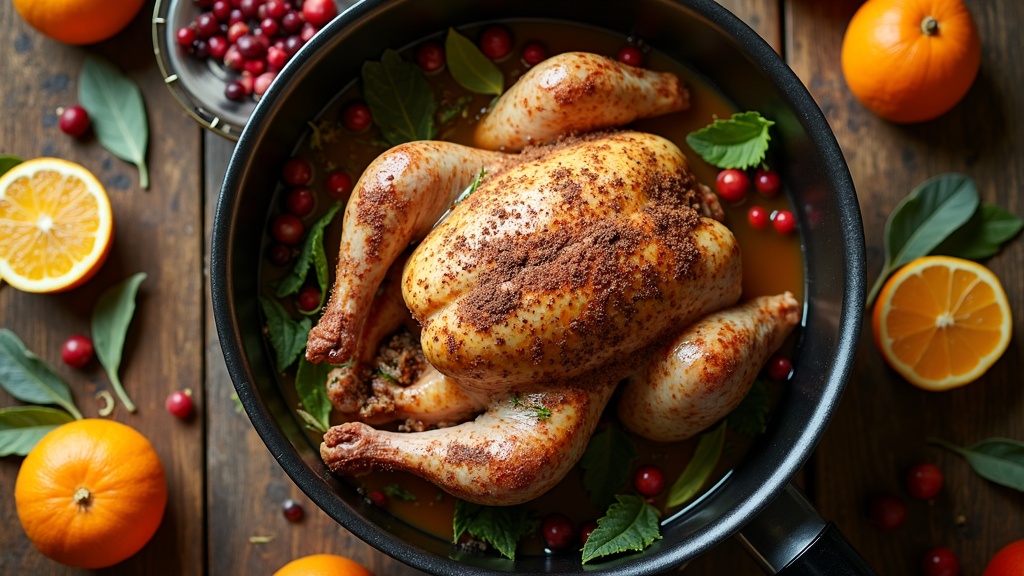Thanksgiving turkey is always the centerpiece of the holiday table, and there’s plenty of passionate discussion about how to prep it. Should you soak it in a brine or give it a dry rub? Both techniques promise juicy, flavorful results, but knowing which is right for you can take your turkey from average to genuinely memorable. Below, I’ll break down each approach, share my own kitchen trials, and hand out some practical tips so your bird gets rave reviews.

The Basics: What’s Brining? What’s a Dry Rub?
Both brining and dry rubbing help boost flavor and give a texture upgrade, but each does it in unique ways. Brining means soaking your turkey in a salty, seasoned liquid that helps it hold onto moisture during roasting. On the other hand, a dry rub is a flavorful mix of herbs and spices that you massage onto the bird, which sticks to the skin and brings instant flavor.
I’ve tested both—sometimes going all-in with a juicy brine, other times swearing by a robust spice rub. The effects are noticeably different, so it’s worth getting a grip on how each one works.
- Brining: This could mean a wet brine (submerging in saltwater, with spices and herbs added) or a dry brine (rubbing salt directly onto the bird and letting it chill in the fridge). The salt breaks down proteins so the turkey stays juicy and tender.
- Dry Rub: You mix up your favorite spices and herbs—sometimes with sugar—then coat the whole bird, making sure to get under the skin when possible. No soaking or rinsing, just let the flavors work their way in before roasting.
How Brining Works (and Why It’s Popular)
Brining has become a staple for Thanksgiving, often because it works well to prevent dry turkey. Soaking a turkey in a brine allows salt to penetrate, drawing in water and seasoning. As it roasts, all that extra moisture sticks around, giving you a juicy bite instead of a dry disappointment.
Scientifically, the salt rearranges the turkey’s proteins to create spaces where liquid—now flavored by your brine ingredients—gets locked in. You can toss in anything from sugar and peppercorns to citrus slices and fresh herbs for more depth.
There’s also the dry brining path: rubbing the bird with salt and letting it rest uncovered in the fridge. Though there’s no liquid, the process draws out moisture, and then, thanks to osmosis, that moisture is sucked back in, now loaded with salt and seasoning. It results in juicy, flavorful turkey without the mess of a wet brine.
What Is a Dry Rub, and What Does It Do?
A dry rub packs a punch of flavor directly onto the skin, forming a crust during roasting. Rub blends usually have salt, pepper, paprika, herbs, garlic powder, and sometimes brown sugar. The adventurous might work in coffee or cocoa powder, but you don’t need to go wild—simple can still win.
Sliding some rub under the skin takes the flavor all the way through each bite. While it doesn’t lock in quite as much moisture as a brine, you’ll get a bolder flavor and a crunchy, golden skin. Dry rubs are less messy and don’t demand loads of fridge space, which is a relief when the Thanksgiving fridge is packed.
Brine or Dry Rub: Key Differences and When to Use Each
Choosing between brine and dry rub really comes down to your priorities: flavor, juiciness, texture, time, and kitchen setup. Here are the main contrasts:
- Moisture: Brining excels at keeping the bird juicy, especially if you tend to overcook by accident. Dry rubs can add some help, but won’t penetrate as deep.
- Flavor: Brines send the flavor deeper into the meat; dry rubs focus flavors on the skin and just beneath, giving a big punch with each bite.
- Prep Time: Brining asks for up to 24 hours and requires serious fridge space for a big container. Dry rubs are quick to make, take minutes to apply, and deliver solid results even without an overnight rest—though sitting overnight helps.
- Texture: Brined turkey turns out tender but may lead to softer skin if you skip drying it well. Dry rubs yield crispier, darker skin loaded with flavor.
- Kitchen Logistics: If space is tight, dry rub or dry brine is the way to go. A rack on a baking pan works fine in the fridge, keeping mess at bay and letting air dry the skin for crispness.
How to Wet Brine Your Turkey Step-by-Step
Wet brining isn’t tricky, but you’ll want to plan ahead to fit it into your prep schedule. Here’s how:
- Mix the Brine: Grab a 12- to 14-pound turkey and use about 1 cup kosher salt per gallon of water. Dissolve salt (plus up to half a cup sugar per gallon if using) in warm water, then stir in cold water, bay leaves, peppercorns, garlic, herbs, and say, a strip of orange peel if you like.
- Submerge the Turkey: Remove the giblets, pop the turkey into a large food-safe bucket or cooler, and pour in the brine. Make sure it’s completely submerged (a plate helps).
- Let It Soak: Refrigerate for 12 to 24 hours. If time is short, 6 hours is enough to upgrade flavor, but more is better.
- Rinse and Dry: Rinse the turkey in cold water to wash off extra salt. Pat very dry with paper towels and let air-dry in the fridge for a few hours to give the skin a boost at roasting time.
- Get Roasting: Season as you like with butter, spices, or oil, then roast away.
How to Dry Brine Your Turkey Step-by-Step
If you want less mess and hands-off prep, dry brining is a winner. Here’s what I do:
- Add the Salt: Sprinkle 1 tablespoon kosher salt per 4 pounds of turkey. Work it onto the skin and into the cavity. Mix in herbs, pepper, and garlic powder if you want extra flavor.
- Rest Uncovered: Put the turkey breast-side up on a rack over a baking sheet in the fridge. Let it sit uncovered for 24–48 hours; even 12 hours helps in a crunch.
- Get Cooking: There’s no rinsing. Just blot any moisture, smear with oil or butter if you want, and start roasting.
How to Use a Dry Rub on Turkey
If you want bold, stand-out flavor, dry rubs come to the rescue. Here’s my favorite process:
- Mix the Rub: Blend 3 tbsp kosher salt, 2 tbsp paprika, 2 tbsp brown sugar, 1 tbsp black pepper, 1 tbsp garlic powder, 2 tsp dried thyme, and 2 tsp dried sage. Make it your own—add spices you love.
- Apply the Rub: Pat the turkey dry and work the rub everywhere, including under the skin for deeper flavor. Getting a little messy is part of the fun.
- Rest It: Let the turkey hang out in the fridge for at least a few hours, loosely covered, ideally overnight for maximum flavor pop.
- Roast: Go straight to the oven—no need to rinse. You’ll get a beautiful crust bursting with flavor.
What to Consider When Choosing Between Brine and Dry Rub
Your choice depends on what’s most important for your holiday meal. Here’s how to make the call:
- Time: Got an extra day or two and plenty of fridge space? Brining (wet or dry) is solid. In a hurry? A dry rub comes through in a pinch.
- Flavor Goal: Want layers of aromatics throughout the bird? Go brine. Prefer bolder seasoning on the outside and crackly skin? Dry rub it.
- Ease: Hate hassle or don’t have room for a sloshing tub? Dry brine or rub is low-fuss and leaves your fridge free for pies and sides.
- Picture-Perfect Skin: Want that golden, crispy Instagram turkey? Dry rub or dry brine, with a little air drying time in the fridge, nails it.
Common Hiccups and How to Bypass Them
- Turkey Too Salty: Don’t go wild with the salt—especially brining. Stick to proven ratios, and rinse well if you use a wet brine.
- Rub Slides Off: Pat the bird dry before you apply the rub, and add a drizzle of olive oil to help everything stick if needed.
- Skin Too Soft: Brined turkeys can end up with less-than-crisp skin. An air-dry in the fridge for a few hours usually solves this easily.
- Bland Meat Inside: Make sure to season under the skin—not just on top—if flavor throughout is your goal.
Advanced Tips for Eye-Catching Turkey
Once you’re comfortable with the basics, try these for extra wow factor:
- Mix It Up: Combine dry brine for juiciness, then toss on a dry rub before roasting for a double-flavor punch.
- Compound Butter: Work herbed butter under the skin to supercharge moistness and richness in the breast meat.
- Go Spatchcock: Remove the backbone and flatten the bird before roasting. It cooks evenly and gives you even more crispy skin, no matter your seasoning technique.
- Stuffing Plans: If you want to serve stuffing from the bird, stick to a dry rub or dry brine—wet-brined turkeys can make stuffing too soggy.
Real Life Examples: How These Techniques Paid Off for Me
I’ll never forget hosting a friendsgiving for turkey skeptics years ago. I did a wet brine with lots of citrus and herbs overnight. Everyone commented on how moist even the breast meat was, and leftovers stayed juicy for days. Another year I took a smoky paprika dry rub approach, letting the turkey sit uncovered overnight in the fridge. The skin was gloriously crisp and the spice aroma had folks hovering near the oven. Both got rave reviews—proof there’s no single right way when you pay attention to details.
Frequently Asked Questions
Question: Can I use both a brine and a dry rub on my turkey?
Answer: Absolutely. After brining and rinsing, pat your turkey dry and put on a dry rub for more layered flavor. Go for a salt-free rub so it doesn’t get too salty.
Question: What’s the difference between a wet brine and a dry brine?
Answer: A wet brine involves soaking the turkey in salted water, while a dry brine relies on sprinkling salt and seasonings directly on the bird. Both keep things juicy, but dry brining is less messy and helps get crisper skin.
Question: How far in advance should I season my turkey?
Answer: Wet brines need 12-24 hours ahead. Dry brines and dry rubs can go on overnight, up to two days in advance for dry brining.
Bottom Line: Pick the Method for Your Thanksgiving Style
Whatever you choose—brine, dry rub, or both—each method makes a noticeable impact on your turkey’s flavor and juiciness. Think about your time, fridge space, and flavor priorities before you get started. Don’t stress too much, though; even a turkey with a slipup or two ends up at the center of a table that brings family and friends together.
In my experience, putting thought into seasoning is the best way to take the guesswork out of Thanksgiving. No matter what method you use, a little planning means your turkey will be one people remember and look forward to all year long.
